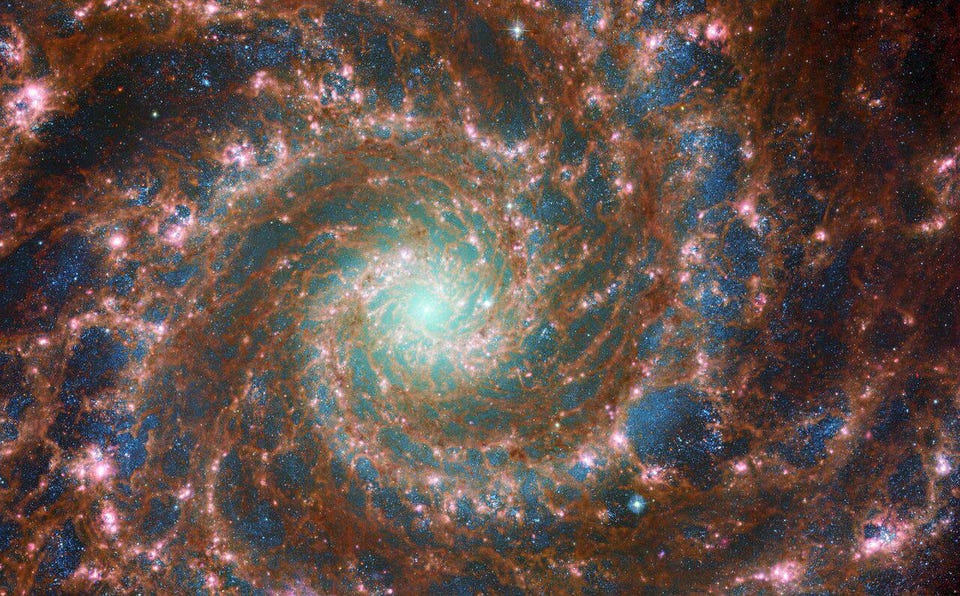Science See And Download The New Webb-Hubble Mash-Up Of A Spiral Galaxy 32 Million Light-Years Away Jamie Carter Senior Contributor Opinions expressed by Forbes Contributors are their own. I inspire people to go stargazing, watch the Moon, enjoy the night sky New! Follow this author to stay notified about their latest stories. Got it! Aug 31, 2022, 08:00pm EDT | New! Click on the conversation bubble to join the conversation Got it! Share to Facebook Share to Twitter Share to Linkedin M74 shines at its brightest in this combined optical/mid-infrared image, featuring data from both .
. . [+] the NASA/ESA Hubble Space Telescope and the NASA/ESA/CSA James Webb Space Telescope.
With Hubble’s venerable Advanced Camera for Surveys (ACS) and Webb’s powerful Mid-InfraRed Instrument (MIRI) capturing a range of wavelengths, this new image has remarkable depth. The red colours mark dust threaded through the arms of the galaxy, lighter oranges being areas of hotter dust. The young stars throughout the arms and the nuclear core are picked out in blue.
Heavier, older stars towards the galaxy’s centre are shown in cyan and green, projecting a spooky glow from the core of the Phantom Galaxy. Bubbles of star formation are also visible in pink across the arms. Such a variety of galactic features is rare to see in a single image.
Scientists combine data from telescopes operating across the electromagnetic spectrum to truly understand astronomical objects. In this way, data from Hubble and Webb compliment each other to provide a comprehensive view of the spectacular M74 galaxy. Links Pan of the Phantom Galaxy Hubble and Webb Showcase M74 Pan of Combined optical/mid-infrared image of M74 (Hubble and Webb) Image A Image C ESA/Webb, NASA & CSA, J.
Lee and the PHANGS-JWST Team; ESA/Hubble & NASA, R. Chandar Acknowledgement: J. Schmidt The European Space Agency (ESA) has published a beautiful new image created by data from both the James Webb Space Telescope (JWST) and the Hubble Space Telescope (HST).
In the wake of JWST’s debut collection in July , images from the billion-dollar space telescope have been few and far between, though we have seen Jupiter in infrared , the most distant star thanks to a ripple in spacetime and a “ring galaxy’” in 4K . The main image published (above) is a mash-up of JWST’s and the Hubble Space Telescope’s (HST) separate images of the “Phantom Galaxy,” a distant spiral galaxy 32 million light-years from the solar system in the constellation of Pisces. The red colours mark dust threaded through the arms of the galaxy while lighter oranges being areas of hotter dust, according to the caption on the download page .
Young stars are blue, old stars are cyan and green while bubbles of star formation are pink. Also published was JWST’s image of M74 as a standalone (below), a clearer version of some earlier images of the same object. It’s available to download for the first time, in HD quality.
This image from the NASA/ESA/CSA James Webb Space Telescope shows the heart of M74, otherwise known . . .
[+] as the Phantom Galaxy. Webb’s sharp vision has revealed delicate filaments of gas and dust in the grandiose spiral arms which wind outwards from the centre of this image. A lack of gas in the nuclear region also provides an unobscured view of the nuclear star cluster at the galaxy’s centre.
M74 is a particular class of spiral galaxy known as a ‘grand design spiral’, meaning that its spiral arms are prominent and well-defined, unlike the patchy and ragged structure seen in some spiral galaxies. The Phantom Galaxy is around 32 million light-years away from Earth in the constellation Pisces, and lies almost face-on to Earth. This, coupled with its well-defined spiral arms, makes it a favourite target for astronomers studying the origin and structure of galactic spirals.
Webb gazed into M74 with its Mid-InfraRed Instrument (MIRI) in order to learn more about the earliest phases of star formation in the local Universe. These observations are part of a larger effort to chart 19 nearby star-forming galaxies in the infrared by the international PHANGS collaboration. Those galaxies have already been observed using the NASA/ESA Hubble Space Telescope and ground-based observatories.
The addition of crystal-clear Webb observations at longer wavelengths will allow astronomers to pinpoint star-forming regions in the galaxies, accurately measure the masses and ages of star clusters, and gain insights into the nature of the small grains of dust drifting in interstellar space. Hubble observations of M74 have revealed particularly bright areas of star formation known as HII regions. Hubble’s sharp vision at ultraviolet and visible wavelengths complements Webb’s unparalleled sensitivity at infrared wavelengths, as do observations from ground-based radio telescopes such as the Atacama Large Millimeter/submillimeter Array, ALMA.
By combining data from telescopes operating across ESA/Webb, NASA & CSA, J. Lee and the PHANGS-JWST Team. Acknowledgement: J.
Schmidt MORE FOR YOU New Research Finds A Connection Between Domestic Violence And These Two Personality Disorders This Scientist Helps Andean Forests And Ecuador’s Women In STEM Exceptional Fossil Preservation Suggests That Discovering Dinosaur DNA May Not Be Impossible The image (above) shows delicate filaments of gas and dust in the spiral arms at the heart of M74, which is known as a “grand design spiral” for its perfect structure. As there’s no dust in the way it’s also possible to see the star cluster at the galaxy’s center. Expect to see a lot of similarly stunning blends of JWST and HST images in the next couple decades.
JWST sees in the infrared part of the spectrum while HST sees mostly in ultraviolet and visible wavelengths. They’re the perfect complement and proof, if any more was needed, that JWST should not be called “the new Hubble. ” Here are the three images, with HST’s on the left, the mash-up in the middle and JWST’s on the right: New images of the Phantom Galaxy, M74, showcase the power of space observatories working together in .
. . [+] multiple wavelengths.
On the left, the NASA/ESA Hubble Space Telescope’s view of the galaxy ranges from the older, redder stars towards the centre, to younger and bluer stars in its spiral arms, to the most active stellar formation in the red bubbles of H II regions. On the right, the NASA/ESA/CSA James Webb Space Telescope’s image is strikingly different, instead highlighting the masses of gas and dust within the galaxy’s arms, and the dense cluster of stars at its core. The combined image in the centre merges these two for a truly unique look at this “grand design” spiral galaxy.
Scientists combine data from telescopes operating across the electromagnetic spectrum to truly understand astronomical objects. In this way, data from Hubble and Webb compliment each other to provide a comprehensive view of the spectacular M74 galaxy. Links Pan of the Phantom Galaxy Hubble and Webb Showcase M74 Pan of Combined optical/mid-infrared image of M74 (Hubble and Webb) Image A Image B ESA/Webb, NASA & CSA, J.
Lee and the PHANGS-JWST Team; ESA/Hubble & NASA, R. Chandar Acknowledgement: J. Schmidt JWST’s observations of M74—the first galaxy it studied after “first light’ in July 2022—was part of the international Physics at High Angular resolution in Nearby GalaxieS ( PHANGS ) survey now using Webb to survey the stars, star clusters, and dust that lie within 19 nearby galaxies.
All 19 have already been observed and imaged by HST. The aim is to reveal early star formation when gas collapses to form stars and heats up the surrounding dust. It’s hoped that JWST’s infrared observations can add new data on the location of star-forming regions in the galaxies.
They should also help astronomers calculate the masses and ages of star clusters. The images come from JWST’s MIRI instrument, which was contributed by ESA and NASA. MIRI, which stands for Mid-Infrared Instrument, is a camera and a spectrograph that sees light in the mid-infrared region of the electromagnetic spectrum.
Webb is the most ambitious and complex space science telescope ever constructed, with a massive 6. 5-meter primary mirror that will be able to detect the faint light of far-away stars and galaxies. It’s designed to detect infrared light emitted by distant stars, planets and clouds of gas and dust.
It’s initial 10-year mission Webb will study the solar system, directly image exoplanets, photograph the first galaxies, and explore the mysteries of the origins of the Universe. Wishing you clear skies and wide eyes. Follow me on Twitter or LinkedIn .
Check out my website or some of my other work here . Jamie Carter Editorial Standards Print Reprints & Permissions.
From: forbes
URL: https://www.forbes.com/sites/jamiecartereurope/2022/08/31/see-and-download-the-new-webb-hubble-image-of-a-grand-design-spiral-galaxy-32-million-light-years-away/



